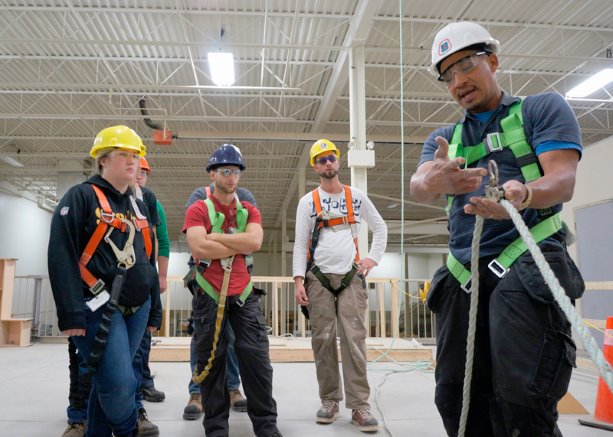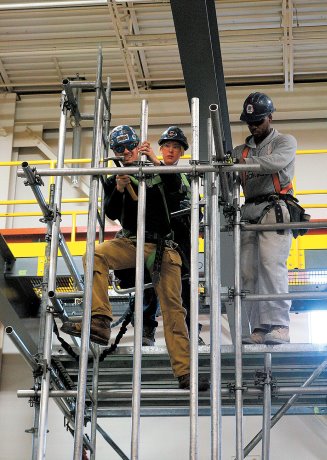In the 1950s, health and safety training in the workplace was rare in many parts of Canada.
In 1954, the province of Newfoundland hired its first safety officer on a three-month contract and two years later they sent a safety person to workplaces in remote communities by boat to deliver first aid supplies.
Safety standards improved slowly but steadily in the decades to come, but in the last 20 or so years the industry started taking the issue more seriously. In Newfoundland, for example, lost-time injury rates per 100 workers dropped to 1.8 last year from a rate of 6.3 in 1996, the year the Newfoundland and Labrador Construction Safety Association (NLCSA) was founded.
Chalk the change largely up to a shift in attitudes, says Jackie Manuel, CEO of the safety association.
Over the last two or so decades associations like the NLCSA have developed hazard-specific training courses such as fall protection, working in confined spaces and transportation of hazardous goods.
Increasingly training has come about because of provincial regulations and, as a case in point, mandatory training standards introduced in Newfoundland in 2010 set the bar high on the "quality and calibre of training being delivered" to workers, explains Manuel.
She sees "the next wave" or push for training to be focused on supervisors.
"It is where we as an industry, a province and a country have the greatest opportunity to have the greatest impact," she says.
Early this year, the association started a 16-hour course on a supervisor’s role and responsibilities concerning safety, says Manuel, adding the response from participating contractors has been positive and a number of companies are seeing safety improvements to their operations.
On the other side of the country, B.C. has seen "tremendous growth" in health and safety training for construction supervisors in recent years, says Urvi Ramsoondar, assistant director of the BC Construction Safety Alliance (BCCSA).
That emphasis is a key factor in a notable drop in incident rates.
The injury rate in 2015 in B.C. was 4.1, down from 7.3 in 2000.
"It means that tens of thousands of workers were not being injured in 2015 that statistically were being injured in 2000," says Grant McMillan, strategic advisor for the Council of Construction Associations (COCA).
In B.C. the top three causes of workplace injuries are: falls from elevation, falls or trips from the same height and being struck by moving equipment or objects in the workplace, explains McMillan.
But increased training and usage of fall protection systems, better guardrail construction and improved site cleanup procedures all factor in to a safer workplace.
Ironically, he says reduced injury rates are occurring when construction activity in B.C. is its busiest ever — a time when skill shortages are a concern in some trades.
"Intuitively, you’d think we should be having more injuries but it hasn’t worked that way. It’s a huge milestone that everyone should take pride in: the construction employer, the supervisors, the workers, the workers compensation system and the board," he points out.
McMillan attributes the safety improvements partly to training onsite by "more educated and trained supervisors" who oversee and manage safety as well as productivity.
And the future bodes well, he says, because technical institutes such as the B.C. Institute of Technology (BCIT) increasingly offer training not only in production but in health and safety.
McMillan says like in other provinces, work needs to be done to reduce fatalities in B.C. but close to 60 per cent of deaths annually are from diseases linked to asbestos from 20 or more years of exposure. The BCCSA has been working closely with WorkSafeBC — the province’s workers’ compensation board — to ensure that protocols are followed concerning asbestos hazards.
Ramsoondar sees the day coming when standardized professional health and safety designations cross provincial borders result in national certifications. This year, the alliance launched the National Construction Safety Officer certification and formed an agreement with all but two provinces for the designation.
Mark Elias, of Ontario’s Infrastructure Health and Safety Association, says for decades the industry knew certain jobs required training but as a workforce and as employers "we were OK with the watch-and-learn-and-try-not-to-get-hurt" mentality.
By tracking data on injuries and fatalities, however, Ontario’s Ministry of Labour has improved safety in the workplace through enforcement of training and critical tasks in the field, he says.
Over a span of 50 years, Elias says that training, which has become required by law for specific workers — take crane operators, sewer workers or even residential carpenters as examples — "has really shaped the way we do our work today and the controls we have in place to make our workplaces safer."
High profile workplace tragedies have had much to do with provincial regulatory changes that have resulted in mandatory training. As an example, after five workers lost their lives in a tunnel fire in Hogg’s Hollow in 1960 in Toronto, tunnel rescue training regulations came into play.
Another tragedy behind change was the swing stage incident on Christmas Eve 2009 in Toronto where four workers died and a fifth was injured. Mandatory training for the Working at Heights program was put in place by the province of Ontario and legislation for swing stage training was introduced in January.
But in 2005, before Ontario made those regulations, the Carpenters’ District Council of Ontario (CDCO) required members planning to work on scaffolding to first take a 56-hour health and safety course in scaffolding, says Cristina Selva, executive director, CDCO.
Selva says the unionized sector took a "proactive stance," rather than a "reactive one," which she associates with government.
She says the mid-1980s saw a leap in training programs funded by newly forming union trust funds. The industry realized it had to make big investments into training because governments were not placing it as a top priority.
While training workers has come a long way in Canada in the past few decades, Manuel says "little or no progress" has been made to prevent soft tissue (musculoskeletal) injuries in Newfoundland’s construction industry. Those injuries include sprains and strains that can develop into chronic problems.
How workers do their work is the crux of the issue.
"In workplaces it is often much easier to change tools designs (for ergonomics) than it is behaviour," Manuel points out.












Recent Comments
comments for this post are closed